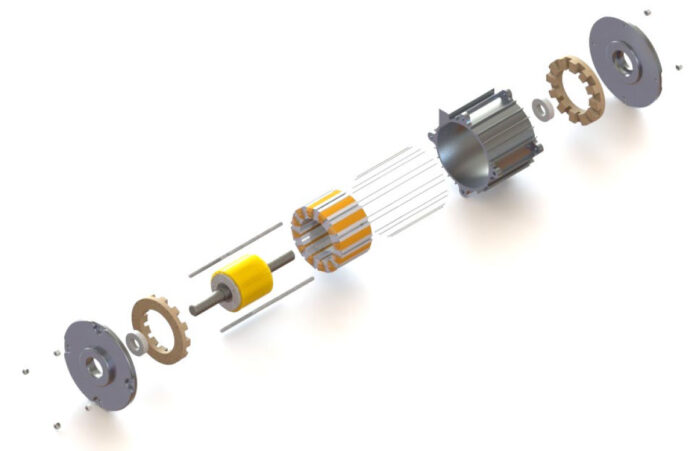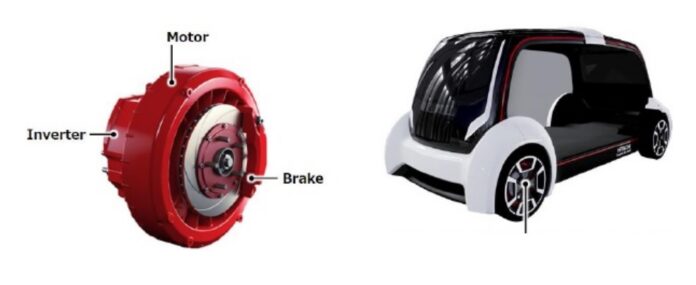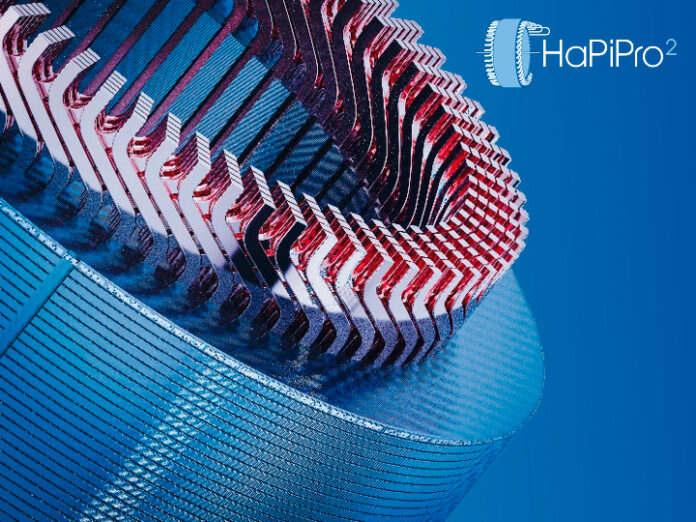QM Power and the SPARK Lab at University of Kentucky shared the combined results of a large-scale, multi-objective design optimization study, and lab testing of a prototype motor designed to meet the ambitious 2025 power density goals set by the US Department of Energy (DOE). The research demonstrated the high torque and speed capability of QM Power’s innovative permanent magnet motor technology. This, combined with advanced manufacturing and cooling technologies, achieved a record-high 50kW/liter volumetric power density for traction applications such as electric vehicles (EV).
The computational study was conducted at the SPARK Lab and an open frame lab prototype was designed and manufactured by QM Power. Tests and extensive simulations were conducted at University of North Carolina, Charlotte and at University of Kentucky to reveal the best outcome given trade-offs among efficiency, power density and power factor while achieving the DOE 2025 target. In 2019 the US DOE established the 2025 goal as part of an ongoing effort to reduce dependency on resources such as fossil fuels and rare earth magnets. It represents an ambitious 89% reduction in motor volume compared to 2020 targets. This project is among the programs which the DOE’s Vehicle Technologies Office deems to “have the potential to support radical new vehicle architectures by dramatic volume/space reductions and increased durability and reliability.”
Ambitious electric motor goal from USA
Regal’s edge product tools
Regal Beloit Corporation, specialized in the engineering and manufacturing of high-efficiency electric motors and power transmission products, has recently announced its enhanced Power Transmission Solutions (PTS) Edge tools. Regal’sEdge tools include product selection modules for belt drive, bearing and gearing products and mechanical power components, as well as bearing registration and a belt drive efficiency calculator. These improved Edge tools are easier to use, mobile-friendly and fully integrated to the regalbeloit.com online product catalogue.
Edge product selection modules assist users in selecting the right power transmission mechanical components based on their specific application requirements. Once they install new bearings products, the bearing registration allows users to not only register their bearings but also manage assets on the Regal PT mobile app. The belt drive efficiency calculator helps users to calculate how much money they can save on energy consumption by using Browning™ belt drives.
«The enhanced Edge tools – said Matthew Clemens, DCX marketing specialist at Regal – allow a mobile friendly, integrated customer experience across regalbeloit.com. The modules have been updated to help point customers to common parts, versus made-to-order parts, so the primary selections are readily available».
Motor in the wheel? Here is the proposal by Hitachi
In the past, various companies have already tried developing disruptive zero-emission motors, for instance with motors hidden in the wheel. This frontier has not technically found its benefit, yet, especially owing to the weight hindrance.
Hitachi, more precisely its subsidiary Hitachi Astemo, is trying giving a solution to the problem with the Direct-Drive. In practice, the manufacturer is going to integrate everything in a single component, placing in the wheel the motor, the inverter and the brake to achieve a power/weight ratio of 2.5 kW for each kg. In this way, they can partially eliminate wirings, as well as transmission gears, so improving efficiency up to 30%.
The prototype wheel is 19″, with maximum torque of 960 Nm, operation at 420 volt and maximum power of 60 kW: multiplied by four wheels, the total value would amount to 240 kW.
To avoid undesired contacts between the inverter components and the liquid, the cooling oil circulates in a ring among the various parts, by means of tubes, directly acting on power semiconductors, and then it is conveyed to the motor to cool coils.
A new research centre on electric motors
Due to the funds coming from the RRNP and from structural funds, Turin Polytechnics will collaborate with the Municipality of Pianezza in the creation of a Research Centre for the design of electric motors. The concerned area has been reclassified as “of collective interest ” and will be redeveloped. According to this vision, they have established an agreement that will last for three years: the Municipality of Pianezza must provide the spaces and the intervention projects to allow the start of the collection of events of interest for public and private subjects interested in contributing in the creation of the Centre. In its turn, the Polytechnics will provide the necessary scientific support for the activities of research, study and training that will be held in the centre. The project will permit the conversion of territorial companies through the enhancement of the role of the industry that manufactures motors and of the entire industrial sector chain.
The Rector of the Polytechnics, Guido Saracco, stated: «With this agreement, the Polytechnics adds another important step in the process of support and development for the territorial economy and for the small medium enterprises that are going to start a process of industrial reconversion. With these synergies, we will share in further boosting economy, employment and youth’s education ».
In the photo Guido Saracco, Rector of the Polytechnics and Antonio Castello, Major of the Municipality of Pianezza (To).
University of Perugia: the study on the efficiency of electric cars is starting
One of the hottest issues concerning the electric mobility is the motor efficiency. Concerning this, a study involves the University of Perugia, in the context of a graduation course in industrial engineering. The research programme involves also professors of triennial and master graduation courses in Industrial Engineering in Terni, as well as Genesi Energia company, operating in the sector of the electric mobility engineering and of manufacturing, stocking and use of electric energy from renewable sources.
The study provides for activities of modelling and experimental analysis in electric mobility applications and the creation of predictive models for the assessment of the charge efficiency and of autonomy depending on the mileage. Such predictive models, combined with experimental checks, will be applied on Renault Zoe electric car, made available by Genesi Energia.
«The analysis of efficiency and energy dispersion of the new electric mobility – explained prof. Ermanno Cardelli, director of the Engineering department of University of Perugia – is a still unexplored field that will be fundamental to work at the implementation of the distribution networks of electric energy on roads. Moreover, the research provides for the design and the implementation of a prototype of electric quadricycle with pedal assistance with photovoltaic panels on board: the design of the super light frame, combined with renewable energy sources on board, will allow achieving theoretically unlimited autonomy in day travels».
Sustainable mobility: the excellence Italian National Pole was born
Last July 16th was presented the project of the National Pole of Sustainable Mobility and Manufacturing, also called SMTC, Sustainable Mobility Technology Center, which will be established in TNE spaces of Corso Settembrini 178 in Turin.
We, too, from Electric Motor Engineering were present, to be able to tell you at best this new Italian pride that exceeds a further border and involves more players of different nature: Turin Polytechnics, University, CIM 4.0, API, Turin Trade Chamber, Industrial Union, Piedmont Region and city of Turin.
The target is accompanying enterprises, especially small and medium-size ones, towards a course of innovation and training, giving them the possibility of using sophisticated tools, at disposal just with investments worth million Euros.
 The keyword is technological transfer, a possibility that can be implemented through the creation of a sound network and the contamination between technologies and competences, also due to the establishment of territorial companies, but not only, at the Pole’s.
The keyword is technological transfer, a possibility that can be implemented through the creation of a sound network and the contamination between technologies and competences, also due to the establishment of territorial companies, but not only, at the Pole’s.
Within 2023 this new excellence should become concrete, with Turin at the core of the capability of doing system, to full benefit of research, innovation and technological transfer to offer training services and activities.
All this is completed by a project of sustainable reorganization of an area still unused, feather in the cap of the automotive manufacturing, where the smartest companies will be attracted.
During the launch event, it was possible to visit the pilot lines that will be the technological core of the Pole: the Additive Manufacturing Pilot Line, the Laser Powder Bed fusion and Direct Energy Deposition.
Measuring the efficiency of induction motors: what is the actual scenario?
The EU Regulation requires the measurement of efficiency for induction motors, as the surveillance task demanded to the different EU countries. Toward this goal, induction motors’ manufacturers and surveillance authorities should consider various issues related to measurement aspects, as the instrumentation to be adopted and the expression of measurement uncertainty.
by Edoardo Fiorucci, Dept. Industrial and Information Engineering and Economics, University of L’Aquila – Italy
The efficiency measurement is a critical issue in the induction motors market that concerns electric motors manufacturers, suppliers, consumers, and market surveillance authorities.
International Standards and Regulations
In 2009, the European Commission published the Regulation EC 640/2009) [1] concerning requirements for the eco-compatible design of electric motors.
This Regulation applies to single speed, three-phase 50 Hz or 50/60 Hz, squirrel cage induction motor, with 2, 4, and 6 poles, rated voltage up to 1 000 V, rated output power between 0,75 kW and 375 kW, continuous duty operation.
This Regulation does not apply to motors designed to operate wholly immersed in a liquid or integrated into a product (gear, pump, fan, or compressor), brake motors, and motors specifically designed to operate in particular environmental conditions.
This Regulation requires the measurement of efficiency for induction motors, as the surveillance task demanded to the different EU countries.
Toward this goal, induction motors’ manufacturers and surveillance authorities should consider various issues related to measurement aspects, as the instrumentation to be adopted and the expression of measurement uncertainty.
If we take a comprehensive look at the measurement procedures and at some basics of the measurement theory, we need to untangle ourselves among standard uncertainty, combined uncertainty, extended uncertainty, indirect and direct efficiency, and separation of losses tolerances of rated values.
Moreover, the standards seem to be not coordinated, so the operators can be in trouble if they aim at evaluating the efficiency with the related uncertainty, as required.
Two first remarks concerning [1] shall be made about uncertainty and tolerance.
In Annex II, the measurement uncertainty is considered, but only from a qualitative point of view: “…For the purposes of compliance and verification of compliance with the requirements of this Regulation, measurements and calculations shall be made using a reliable, accurate and reproducible method, which takes into account the generally recognised state-of-the-art methods, and whose results are deemed to be of low uncertainty, including methods set out in documents the reference numbers of which have been published for that purpose in the Official Journal of the European Union…”
The difference between the output mechanical power and the input electrical power is due to losses occurring in the motor. The determination of total losses shall be carried out by one of the following methods: measurement of total losses, or determination of separate losses for summation.
Tolerances for manufacturers are introduced in Annex III: “The authorities of the Member State shall test one single unit. The model shall be considered to comply with the provisions set out in this Regulation, if in the nominal motor efficiency (η), the losses (1-η) do not vary from the values set out in Annex I by more than 15 % on power range 0,75-150 kW and 10 % on power range > 150-375 kW…”
Although the effort in regulating the efficiency measurements, from an operative point of view, no numerical goals for the uncertainty are given, resulting in the issues we will discuss at the end of this paper.
The IE efficiency levels in [1] are in the IEC 60034-30-1:2014 Rotating electrical machines – Part 30-1: Efficiency classes of line operated AC motors (IE code) [2]. This standard establishes a set of limit efficiency values based on frequency, number of poles and motor power.
Let us consider the combined effects of [1] and [2], on the reference values for the efficiency, in a real scenario.
In Fig. 1, the IEC 60034-30-1 efficiency curves for 2-poles induction motors are depicted, for IE1, IE2 and IE3. The effect of the tolerances in [1] leads to the situation in Fig. 2a, with the effects of +/-(15/10) % uncertainty in power losses.
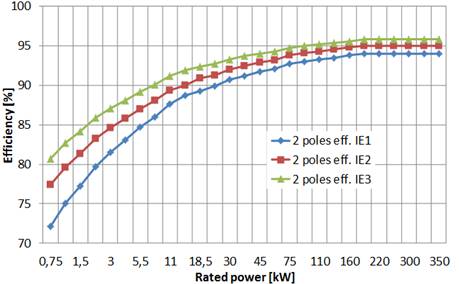
Each curve in Fig.1 should be replaced by a set of two curves, obtained by considering respectively 15 % (induction motors rated power up to and including 150 kW) and 10% (induction motors for rated power induction motors rated power above 150 kW) decrement and increment of the losses related to the IE efficiencies defined by IEC 60034-30-1, according to the rated power.
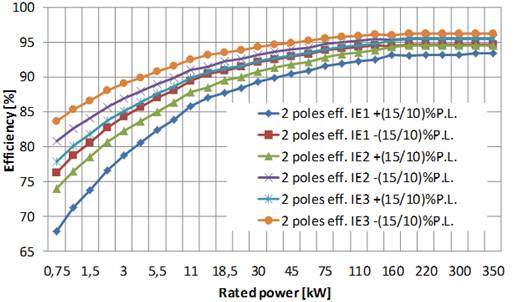
The obtained six curves are in Fig. 2a and Fig.2b. As a first remark, there are some overlaps because the IE2+(15/10)% curve is lower than IE1-(15/10)%curve, and the IE3+(15/10)%curve is lower than IE2-(15/10)% curve.
This issue could involve some difficulties in classifying an induction motor.
For example, the IE1 and IE2 efficiencies required for 5.5 kW 2 poles induction motors are 84.7% and 87%, respectively; the ranges depicted in Fig.2a are 82.40-86.99 for IE1 and 85.05-88.95 for IE2.
Let’s consider a rated efficiency of 86% declared by the manufacturer.
The considered motor can be simultaneously classified as IE1, because its efficiency is lower than % 86.99, but it can also be rated as IE2 because its efficiency is higher than 85.05%.
A similar problem can be raised for the overlaps of IE2 and IE3 curves. In Fig.2b the obtained curves for the higher rated power range are presented, as an expansion of Fig.2a.
Unfortunately, we have not considered the measurement uncertainty, yet.
Is it mandatory for the operators to evaluate the measurement uncertainty if they are measuring and then guaranteeing the rated efficiency of an induction motor?
Regarding the measurement laboratories, the general requirements for the competence, impartiality, and coherent operation of the laboratories are defined in the ISO / IEC 17025: 2017 [3] standard, which applies to all organizations that carry out laboratory activities but also to regulatory authorities and accreditation bodies.
It states that “testing laboratories shall have and shall apply procedures for estimating the uncertainty of measurement”.
So, we must refer to the uncertainty definition in the Guide ISO/IEC 99:2007, International vocabulary of metrology [4] as the “non-negative parameter characterizing the dispersion of the quantity values being attributed to a measurand, based on the information used.”
Coherently, the measurement result is a “set of quantity values being attributed to a measurand together with any other available relevant information”.
It is probably the most critical and neglected aspect in many experimental procedures in all the technical fields; each measurement result must be expressed as a set of data, not as a single point according to the Euclidean geometry.
Because of the impossibility of having zero uncertainty, we must define our results as a data set, whose width we tend to reduce according to the considered application, desired level of knowledge, budget, and available instrumentation.
In this scenario, the JCGM 100:2008 Evaluation of measurement data — Guide to the expression of uncertainty in measurement [5] is fully applicable because it establishes general rules for evaluating and expressing uncertainty in measurement intended to be applicable to a broad spectrum of measurement procedures.
All the above-mentioned recommendations and standards are to be considered together with the IEC 60034-2-1:2014 Rotating electrical machines – Part 2-1: Standard methods for determining losses and efficiency from tests (excluding machines for traction vehicles) [6]; it defines operatively the procedure for the measurement of efficiency.
The test methods are now grouped into preferred methods and methods for field or routine tests.
The preferred methods are presented as methods that allow low uncertainty; for a specific rating and type of machine, only one preferred method is currently defined.
The requirements related to the instrumentation are detailed and refined. Furthermore, the description of all the tests required for each method is explained, in the same sequence needed for the execution of the test itself, with flow diagrams that graphically show the sequence of tests.
As a general remark, it must be noticed an effort to model the effects of many experimental parameters in the evaluation of the different typologies of losses.
Some Experimental Results
In our Laboratory of Electrical Engineering at the University of L’Aquila, we have been testing several induction motors whose rated power is up to 15 kW (400 V, 50 Hz, TEFC, squirrel-cage), both for research and industrial applications since 1994 (Fig. 3).
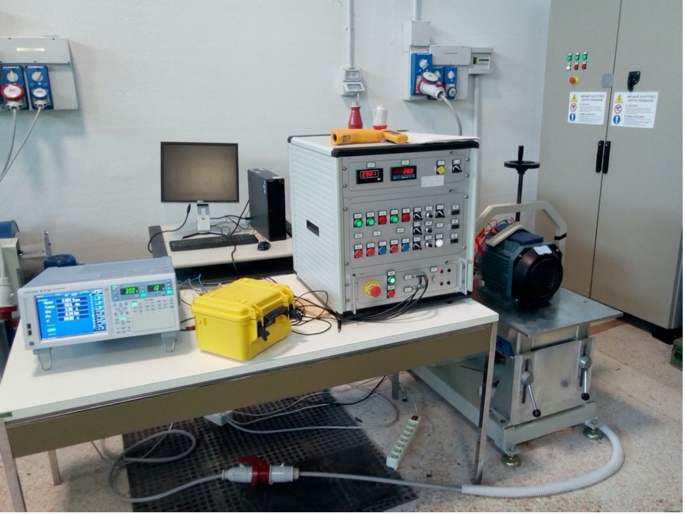
Today, our Laboratory is equipped with state-of-the-art instrumentation.
In detail, in this paper, some results about efficiency measurement according to the current version of the standards [5, 6] are presented.
Fig. 4 shows the experimental testing results for IE3 – 2 poles induction motors; the accuracy achieved in efficiency measurement is ± 0,30 % by adopting high accuracy power analyzers and mechanical transducers.
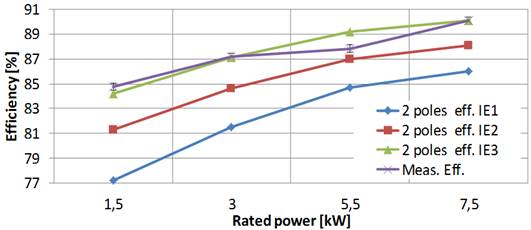
We can observe that only the 5.5 kW motor is below the IE3 efficiency; however, because of the allowed 15% uncertainty in power losses measurement, the manufacturer could correctly classify it as IE3 as suggested by Fig. 5.
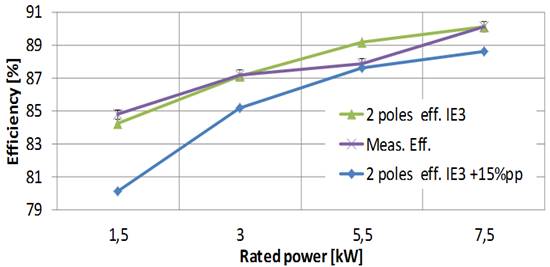
This issue is more evident in Fig.6 for the 4-poles induction motors we tested; all of them are characterized by measured efficiency lower than the IE3 curve, which we have measured with experimental uncertainty of +/-0,40%.
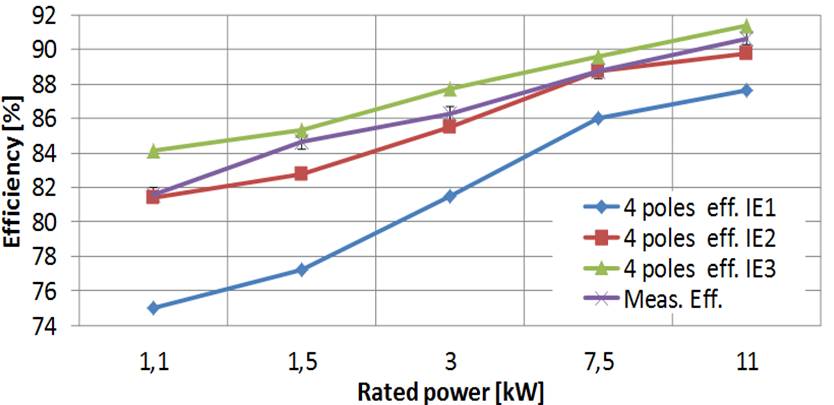
Nevertheless, although all of them are below the IE3 curve, they can be classified as IE3 because the manufacturer can take advantage of the allowed 15% uncertainty (Fig.7).

In other words, even if with a high accuracy measurement of efficiency, we demonstrate that an induction motor is below a rated IE efficiency value, the manufacturer could not be criticized because the EC Regulation N. 640/2009, Annex III allows him to perform the efficiency measurement with low accuracy.
Final Remarks and Conclusion
Finally, some remarks about legal issues can be raised in assigning an efficiency class for a measured efficiency.
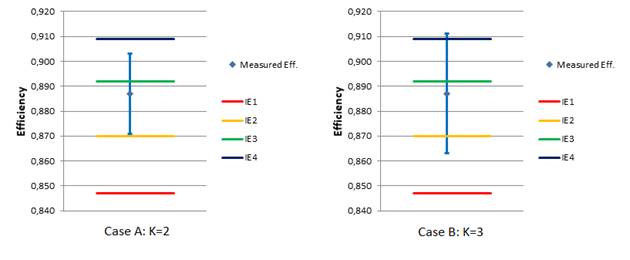
In Fig.8, what is the correct IE class, for a measured efficiency for the case A in which a coverage factor k=2 (95% confidence) is adopted according to the GUM [5]? The motor complies with IE2 requirements because all the data set is over IE2 level.
But I cannot exclude that it is IE3. If we extend the uncertainty, with k=3, (99% confidence), the data set covers 4 IE levels. So, which is the correct IE code for this motor?
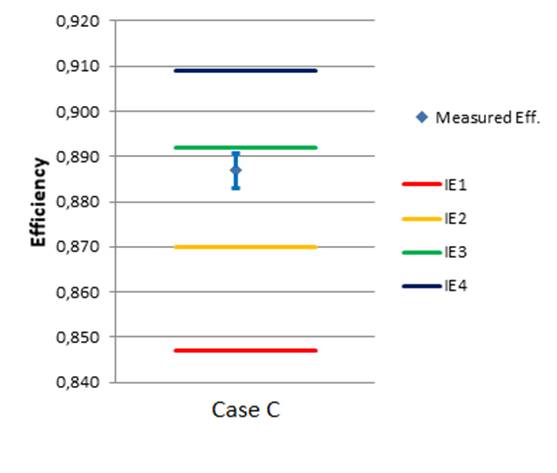
Maybe some additional suggestion of requirements in the international standards can be helpful, starting from the observation that the differences between two contiguous IE levels cannot be thinner than the measurement uncertainty; the desirable scenario is in Fig. 9.
Finally, how are two different data set to be considered if they are different? It is a typical situation in the measurement field. In this case, we must check if they are superimposable.
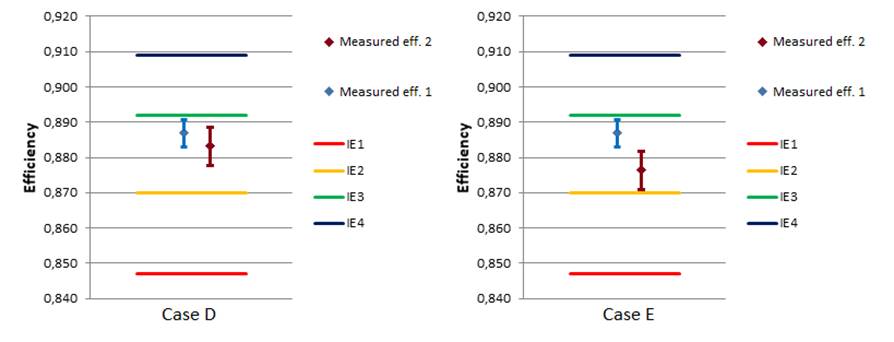
In Fig. 10, case D shows two sets that are compatible because they are partially superimposable.
Case E in Fig. 10 depicts how the measurements are not compatible, even if they lead to the same IE results because the motor complies IE2 level.
Some references that can be of interest to operators involved in this complex scenario are listed as [8-11].
References
[1] COMMISSION REGULATION (EC) No 640/2009 of 22 July 2009 implementing Directive 2005/32/EC of the European Parliament and of the Council with regard to eco-design requirements for electric motors.[2] IEC 60034-30-1:2014 Rotating electrical machines – Part 30-1: Efficiency classes of line operated AC motors (IE code).
[3] ISO/IEC GUIDE 99:2007 International vocabulary of metrology — Basic and general concepts and associated terms (VIM).
[4] ISO/IEC 17025:2017 General requirements for the competence of testing and calibration laboratories.
[5] SO/IEC Guide 98-3:2008 (JCGM/WG1/100) Uncertainty of measurement — Part 3: Guide to the expression of uncertainty in measurement (GUM:1995).
[6] IEC 60034-2-1:2014 Rotating electrical machines – Part 2-1: Standard methods for determining losses and efficiency from tests (excluding machines for traction vehicles).
[7] Power Analyzer Accuracy and Basic Uncertainty Calculator R511.xls, 2021, [online] Available: http://tmi.yokogawa.com/.
[8] Rajan, A., Kuang, Y.C., Ooi, M.P.-L., Demidenko, S.N. Measurement uncertainty evaluation: Could it help to improve engineering design? (2019) IEEE Instrumentation and Measurement Magazine, 22 (2), art. no. 8674631, pp. 27-32. DOI: 10.1109/MIM.2019.8674631.
[9] G. Bucci, F. Ciancetta, E. Fiorucci and A. Ometto, “Uncertainty Issues in Direct and Indirect Efficiency Determination for Three-Phase Induction Motors: Remarks About the IEC 60034-2-1 Standard,” in IEEE Transactions on Instrumentation and Measurement, vol. 65, no. 12, pp. 2701-2716, Dec. 2016. DOI: 10.1109/TIM.2016.2599459.
[10] Dubois, C., Leblond, L., Pou, J.-M., Ferrero, A. Covariance evaluation by means of uncertainty assessment (2016) IEEE Instrumentation and Measurement Magazine, 19 (6), art. no. 7777646, pp. 12-18. DOI: 10.1109/MIM.2016.7777646.
[11] Bucci, G., Ciancetta, F., Fiorucci, E., Mari, S., Segreto, M.A. The measurement of additional losses in induction motors: Discussion about the actually achievable uncertainty (2019) Energies, 13 (1), art. no. 78. DOI: 10.3390/en13010078.
Ford project that studies the electric motors of the future
In Germany, Ford with other partners has created a consortium to develop next-generation electric motors, to study new production processes.
The research project is called HaPiPro 2 and its target is developing new base products and processes that will play a protagonist role in the mass-production of components for electric vehicles, exploiting flexible, scalable and efficient methods.
The name HaPiPro 2 refers to the pin technology used in the wire winding inside electric motor groups: the Hairpin technology is a key innovation area in electric drive systems and the research will study precisely how to exploit its potential to allow the efficient manufacturing of several electric motor variants on a single production line.
The consortium includes, besides Ford, Thyssenkrupp System Engineering, Rwth and Engiro departments of 3D printing and product engineering of the University of Aachen, and electric motor experts.
The new research centre will be hosted inside Ford factory in Koln -Niehl, in Germany, “a unique advanced engineering platform for all companies, to research and to assess the future of electric motor manufacturing processes», as Gunnar Herrmann, executive President of Ford in Germany, described.
In Canada 100% electric seaplanes
Completely composed by seaplanes, the Canadian airline Harbour transports over half million passengers yearly and it has recently announced it is going to convert all aircrafts of its property, equipping them with electric motors. Through an agreement with the company magniX that will supply propulsors, Harbour Air will therefore go down in history as one of the first fully electric airline companies.
The protagonist motor of this change is magni500 and the pioneer aircrafts of this installation are DHC-2 de Havilland Beaver. The motor develops 750 horsepower with an autonomy of more than one hour. Besides, considering that the vast majority of flights performed by Harbour Air last around half an hour, it is an excellent opportunity in both economic and environmental terms. Maintenance will be facilitated by a more user-friendly management of motors, with compulsory check cycles in longer times than with standard motors.
When will the transition from traditional to electric occur? It seems that it might even be accomplished by 2021, carrying out all twelve routes currently in operation.
The innovative Wcs wind generator
It is worth saying: a wind of news is coming for the renewables of the future.
The Norwegian start-up Wind Catching Systems, established in 2017, has in fact designed an offshore wind turbine with an innovative floating wind power technology at competitive prices, which will make its debut in 2026.
The visual impact is impressive: the Windcatcher grid, a giant vertical net, over 324-metre high, whose meshes are hundreds of mini-wind turbines connected one another, arranged on a floating platform moored on the ocean floor.
The target is revolutionizing the technology for the offshore wind catching, a system competitive enough to operate without incentives, maximizing the energy production.
According to Wcs start-up, only one of these wind turbines might offer the double of the area exploited by the biggest standard wind turbines in the world and the smaller rotors can work much better even with wind speeds included between 40 and 43 km/h (27 mph). The overall effect, Wcs affirms, is the 500% rise of the yearly energy production.
Actually, each of these plants might replace five big single-turbine plants.
Wcs affirms these plants are ready for a service life of 50 years, compared to 30 years of a single large turbine.
Speaking of economic aspects, the plant is expected to supply offshore wind energy with the same cost as grid energy. In Norway, the average is currently about 86 Euros per megawatt hour and for their debut, in approximately 5 years, the price might even be around 80 Euros.

